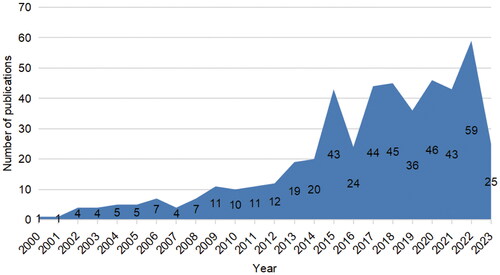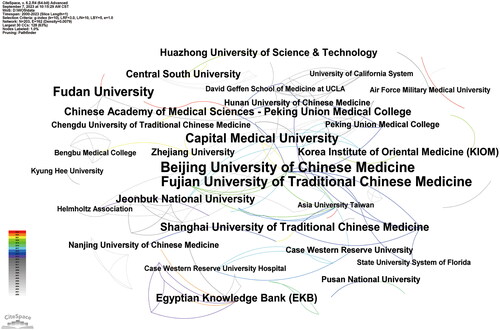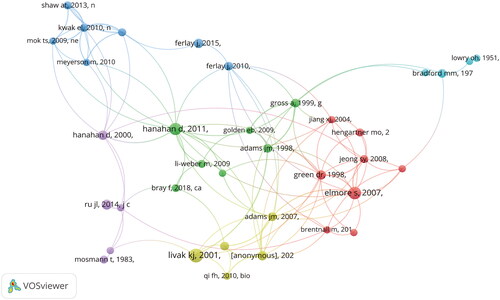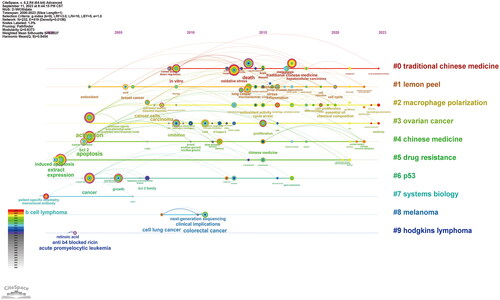Abstract
Context
Traditional Chinese Medicine (TCM) is effective as a cancer treatment modality. However, this is the first bibliometric analysis of TCM in lymphoma treatment.
Objective
This study explores the current trends and research topics of TCM in treating lymphoma from 2000 to 2023.
Materials and methods
We searched within the Web of Science Core Collection (WoSCC) for publications on TCM in lymphoma treatment, spanning 2000 to 2023. Subsequently, we employed a comprehensive approach utilizing CiteSpace software and VOSviewer to visually analyze research trends, authors, institutions, co-cited references, and keywords.
Results
From January 1, 2000, to August 31, 2023, annual scientific publications on TCM for lymphoma treatment have steadily increased. Among the leading institutions in this field, the Beijing University of Chinese Medicine and the Fujian Medical University occupied the top positions. Regarding the authors, Jun Peng, Jiumao Lin, and Hongwei Chen emerged as the top three contributors. In the co-citation analysis of references, the top three co-cited references were authored by Hanahan D, Elmore S, and Livak KJ with citations numbered 13, 14, and 17, respectively. In particular, keywords reflecting current emerging trends included ‘pathway’, ‘traditional Chinese medicine’, ‘oxidative stress’, and ‘macrophage polarization’.
Discussion and conclusions
This bibliometric analysis provides a comprehensive overview of TCM for lymphoma treatment. This analysis identified the predominant trends and research topics in the field. The findings are expected to be of significant value for researchers who focus on TCM in lymphoma treatment, helping them better understand the development of this field.
Introduction
Lymphoma represents a group of hematologic malignancies that develop predominantly within the lymph nodes (Xie et al. Citation2015). According to the 2020 GLOBOCAN data analysis, malignant lymphoma ranks ninth globally among all malignancies and tenth in mortality (Sung et al. Citation2021). Despite advances in medical approaches and the advent of gene-targeted therapy, most patients still receive their diagnosis at an advanced stage of the disease due to the elusive nature of this condition. Currently, the primary treatment modalities for lymphoma involve systematic chemotherapy and radiotherapy. However, due to tumor heterogeneity, toxic side effects, and the emergence of drug resistance in systemic chemotherapy, patient outcomes are compromised, impacting both prognosis and quality of life (Boussios et al. Citation2012). Therefore, the quest for novel, effective, and safe therapeutic agents is now a pressing imperative.
Traditional Chinese Medicine (TCM) is one of the most enduring and continuously practiced herbal medicine systems with a rich history. More than two millennia have passed since the documented application of TCM in cancer treatment in Chinese medical texts and publications. TCM has attracted significant attention recently for its crucial role in cancer prevention and treatment. Numerous studies have shown that the bioactive components of TCM exhibit the ability to induce apoptosis (Fang et al. Citation2012), inhibit tumor progression (Zhang et al. Citation2007), and induce cell cycle arrest (Wang et al. Citation2012). Furthermore, the combination of anticancer TCM compounds exhibits considerable promise in cancer therapy. For example, Zhang et al. (Citation2018) observed that combining curcumin and cisplatin improves therapeutic efficacy against non-small cell lung cancer. Resveratrol and curcumin synergistically induce apoptosis in breast cancer cells caused by cigarette smoking by suppressing Hedgehog-Gli signaling via p21 Waf/Cip1 (Mohapatra et al. Citation2015). Xia et al. (Citation2015) demonstrated that combining cryptotanshinone and anticancer drugs can reverse resistance to cisplatin in human lung carcinoma A549 cells by inhibiting the nuclear factor erythroid 2-related factor 2 (Nrf2) pathway. Furthermore, Che et al. (Citation2014) reported that the combination of As2O3 and the ginsenoside Rg3 significantly affected lung cancer treatment, markedly reducing NCI-H1299 cell proliferation, prolonging the survival of tumor-bearing nude mice, and promoting tumor cell apoptosis.
Bibliometric analysis, a comprehensive statistical approach based on publications, serves as an effective means to analyze the evolution of an academic discipline (Zhang et al. Citation2021). In our search for deeper information on the trajectory and patterns of TCM in lymphoma treatment, we conducted an extensive investigation, obtaining 486 pertinent articles from the Web of Science Core Collection (WoSCC). Leveraging CiteSpace and VOSviewer’s analytical tools, we conducted bibliometric examinations and visual analyses encompassing research trends, authors, institutions, co-cited references, and keywords. These findings will guide scholars in this field and enable them to conduct more comprehensive and in-depth research.
Materials and methods
Data source and search
Bibliometric analysis was conducted using the WoSCC, one of the most multidisciplinary, authoritative, and systematic databases (AlRyalat et al. Citation2019). It provides detailed information about publications, such as the number of annual publications, institutions, author’s information, keywords, references, and more. Renowned for its multidisciplinary coverage, the WoSCC is widely acknowledged as the optimal database for bibliometric analyses (Xu et al. Citation2022). All data were from the WoSCC between January 1, 2000 and August 31, 2023 and downloaded on September 5, 2023.
The data retrieval strategy was structured as follows: (TS = (lymphoma)) AND (TS = (patent herbal drug OR herbal medication OR Chinese patent medicine OR herbal medicine OR Chinese herbal preparation OR Chinese herbal medicine OR herbal formulas OR herbal extract OR Chinese herbal decoction OR herbal supplement OR Chinese medicine OR herbal products OR traditional Chinese medicine OR traditional herbal medicine OR traditional medicine)). The initial results were refined by applying filters [DT = (Review or Articles) AND LA = (English)].
Inclusion and exclusion criteria
The inclusion criteria were as follows: (1) the research focused on the application of traditional Chinese medicine in lymphoma, (2) the literature was published between January 1, 2000, and August 31, 2023, (3) the literature was written in English, and (4) the types of literature were limited to ‘REVIEW’ or ‘ARTICLE’. Exclusion criteria were: (1) types of literature categorized as letters, reports, or conference proceedings, (2) articles written in languages other than English, (3) studies where the primary content did not involve the application of traditional Chinese medicine, and (4) publications that did not demonstrate the use of traditional Chinese medicine in the context of lymphoma.
Data analysis and visualization
To ensure data integrity and authenticity, two researchers independently cross-verified accuracy by retrieving the raw data from the WoSCC. We used CiteSpace software (version 6.2.R4) to eliminate duplicate entries, resulting in 486 unique publications. Subsequently, CiteSpace software was used to analyze and visualize the interconnections between research trends, authors, countries, institutions, and keywords. The software settings were configured as follows. The time frame was set from January 2000 to August 2023. Each slice represented a one-year interval. The selection criteria was the g-index, and the scale factor was k = 9. All other parameters were at their default values. We utilized VOSviewer with a map threshold set at five for the co-citation analysis.
Results
Trend analysis of annual publication
Based on data gathered from the WoSCC database, 486 articles were published between 2000 and 2023, comprising 406 research articles, 67 review articles, and 13 articles of other categories. To chart the trend, we calculated the annual count of articles. The number of publications related to TCM in lymphoma treatment showed a consistent upward trajectory, from 1 article in 2000 to 59 articles in 2022, with a slight decrease in 2023 ().
Analysis of institutional publications
Visualized institutional networks provide information on collaborative relationships among various research teams (Peterson et al. Citation2019). presents the 11 leading research institutions based on the number of publications. highlights that the Beijing University of Chinese Medicine is the research institution with the highest publication count, indicating its substantial contribution to advancing this field. However, it has limited collaboration with other research institutions. However, Fujian Medical University is second in the number of publications but has partnered with only two research institutions. This suggests that Chinese research institutions can benefit from fostering greater cooperation to further advance the development of TCM in lymphoma treatment.
Table 1. Top 11 institutions with the most publications in the field of traditional Chinese medicine therapy for lymphoma.
Analysis of the authors
Analyzing collaborative relationships among authors can provide valuable information on the productivity of individual authors and research groups in anti-lymphoma research within TCM. As shown in , the author who has contributed significantly to this field is Jun Peng, who has authored ten articles. Jiumao Lin holds the second position with seven published articles, followed by Hongwei Chen, who has written five articles ().
Figure 3. Visualization diagram of the cooperation network of authors in lymphoma research of traditional Chinese medicine treatment.
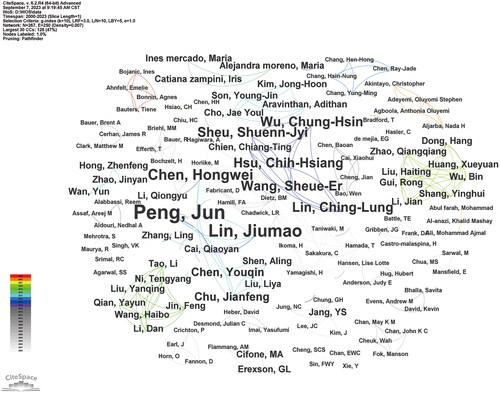
Table 2. Top 10 most productive authors in the field of traditional Chinese medicine therapy for lymphoma.
Co-citation analysis of references
Among the 24,240 co-cited references cited in the retrieved articles, 39 references have been cited more than five times. presents a network that illustrates co-cited reference clusters, which facilitated categorizing articles into six clusters, encompassing 36 items, 103 links, and a cumulative link strength of 132. Notably, by observing the label and circle sizes in the figure, the top three co-cited references are Hanahan and Weinberg (Citation2011), Elmore (Citation2007), and Livak and Schmittgen (Citation2001), which were, respectively, cited 13, 14, and 17 times.
Keyword analysis
The keywords in the articles accurately reflect active research topics (Torres et al. Citation2021). To identify the current active research areas and trends within TCM for lymphoma treatment, we gathered 258 keywords from the 486 publications for co-occurrence analysis using CiteSpace software. The investigation revealed that in the past two decades, keywords such as apoptosis, expression, activation, oxidative stress, traditional Chinese medicine, and cancer cells have received substantial attention (). The top 10 clusters included traditional Chinese medicine, lemon peel, macrophage polarization, Chinese medicine, etc ().
Figure 5. The network and cluster diagram of keyword co-occurrence analysis. (A) Co-occurrence network of keywords of the application of traditional Chinese medicine in lymphoma. (B) Cluster analysis of keyword co-occurrence networks.
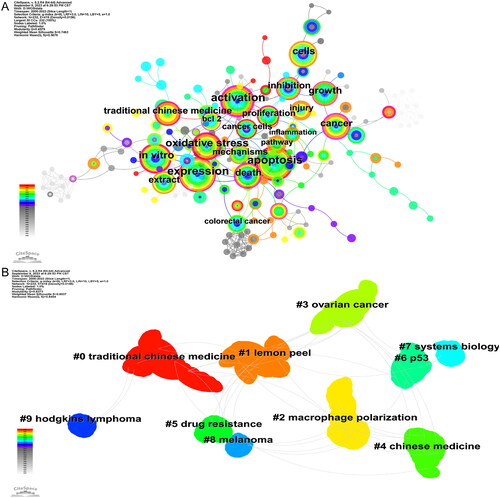
Identifying ‘burst keywords’ among all keywords can help predict future study trends and emerging areas of interest. presents the 20 main keywords with the most robust citation bursts. Among these, ‘inhibition’ was the first keyword with a burst detected in 2009. Subsequently, research focused on the induction of apoptosis, cell death, and resistance. From 2018 to present, pathway, TCM, oxidative stress, and cancer had become prominent topics. These findings signify an increasing interest in TCM within lymphoma research and may indicate potential future research frontiers in this domain.
Figure 6. Top 20 keywords with the strongest citation bursts in traditional Chinese medicine therapy for lymphoma research.
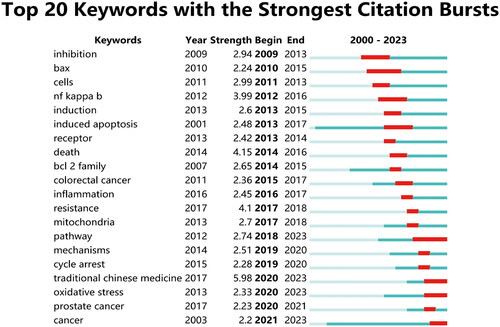
The timeline viewer reveals the progression of the keyword clusters over time (). These clusters, with their corresponding keyword information in the evolutionary process, include TCM, lemon peel, macrophage polarization, ovarian cancer, Chinese medicine, drug resistance, p53, systems biology, melanoma, and Hodgkin lymphoma, respectively. Cluster 0, marked as the most significant cluster, transitioned from non-Hodgkin lymphoma in 2009 to acute lymphoblastic leukemia in 2023. This evolution highlights critical topics such as oxidative stress, resistance, and cell death. In Cluster 1, which spans from antioxidants in 2003 to bioactive compounds in 2022, the development of active research areas demonstrates a diverse trajectory, encompassing acid, breast cancer, therapy, lung cancer, mechanisms, Chinese herb medicine, gastric cancer, and cell cycle, among others. Cluster 4 notably features apoptosis as the central node, indicating its status as a critical research topic within this field.
Discussion
TCM has gained widespread recognition as an effective cancer therapy, capable of reducing tumor proliferation, inducing apoptosis, and mitigating complications (Hong et al. Citation2015). Many TCM approaches have found acceptance as alternative cancer treatments. Research has shown that bitter cold herbal medicine, for example, exhibits notable effectiveness against tumors with minimal toxicity, limited side effects, and impacts on cancer outcomes (Shen et al. Citation2022). To advance drug development and clinical trials, it is imperative to enhance our understanding of the role of TCM in lymphoma treatment. This study marks the first analysis of the application of TCM in the evolution and trends of lymphoma treatment from 2000 to 2023, examining annual publication trends, authorship patterns, institutional collaborations, co-cited references, and keywords to illuminate this significant field.
In the past 22 years, there has been a notable upsurge in using TCM to treat lymphoma. Most articles in this domain have been published within the past decade, representing more than 83% of total publications. This underscores the continuous exploration and increasing attention to TCM applications in lymphoma research. Furthermore, it reflects the progressive maturation of TCM research in lymphoma treatment, aligning with the growing trends in TCM applications (Guo et al. Citation2020). Active participation and contributions have come from institutions such as Beijing University of Chinese Medicine, Fujian University of Traditional Chinese Medicine, and Fudan University. However, the level of interaction and collaboration among these leading institutions in TCM for lymphoma treatment appears to be less robust, suggesting ample opportunities for enhanced collaborative research endeavors. Scientific collaboration takes on various forms, and one common method to evaluate it in the scientific community is through co-authorship (Uddin et al. Citation2013).
The author analysis reveals that Jun Peng, Jiumao Lin, and Hongwei Chen are the most productive authors. In particular, all three authors come from the Fujian University of Traditional Chinese Medicine and exhibit a cooperative relationship. These results reveal that Chinese institutions contributed the most to the overall development of this field. This concentration of expertise is not surprising given that China, both in terms of authors and institutions, contributes the most to this field and has a leadership role. With its extensive clinical history in China, TCM has many potential applications due to its multi-component, multi-target characteristics and a notable capacity for synergistic effects in treating various diseases with minimal side effects (Li et al. Citation2021). During the internationalization of TCM, it is imperative to support collaborative research involving authors and institutions from both domestic and international arenas despite the encouraging prospects it presents.
Co-cited references measure the frequency with which two publications are cited together, providing insight into the intellectual connections between scientific concepts (Sugimoto et al. Citation2019). Our study examined the network of co-cited reference clusters, categorizing papers into six distinct clusters, encompassing 36 items, 103 links, and a combined link strength of 132. When considering the size of the labels and circles within the figure, it becomes evident that the top three ranked co-cited references, Hanahan and Weinberg (Citation2011), Elmore (Citation2007), and Livak and Schmittgen (Citation2001), originate outside China. These citations within the scientific literature underscore that knowledge is not isolated but part of a broader network of connections and extensions. Therefore, although TCM has a rich history in China, spanning over 2000 years, and has been used in the prevention and treatment of numerous diseases, it remains imperative for Chinese institutions and authors in this field to strengthen their collaborative efforts with international counterparts. Collaboration is vital to improve the globalization of TCM (Zhu et al. Citation2020).
Keyword analysis plays a crucial role in elucidating the central themes of a publication, shedding light on the dominant trends within a particular field, and helping researchers navigate the prevalent research areas (Xiao et al. Citation2017). In this study, our keyword co-occurrence analysis revealed that terms like apoptosis, expression, activation, oxidative stress, TCM, and cancer cells have been prominent over the past two decades. This underscores that research focused on apoptosis, expression, activation, oxidative stress, and TCM application in lymphoma therapy has been one of the compelling research topics.
Previous studies have shown that TCM, as a promising antitumor natural therapy medicine, can inhibit cell invasion, induce cancer cell apoptosis and migration, and regulate cell signal pathways (Wang et al. Citation2022). For example, Poplar propolis affects apoptosis of DLBCL SU-DHL-2 cells by down-regulating the serine/threonine protein kinase PLK (Liu et al. Citation2023). Through CRM1-mediated accumulation of p62/SQSTM1 and activation of AMPK, TCM-derived sulforaphane improves autophagic cell death in lymphoma cells (Wang et al. Citation2018). It is now widely recognized that modulation of oxidative stress plays a vital role in cancer cell proliferation, adaptation, and resistance to therapy (Bruzzese et al. Citation2013; Leone et al. Citation2015).
Burst detection algorithms, which identify rapid spikes in citations or keyword popularity over a short period of time, effectively pinpoint emerging research areas (Chen et al. Citation2014). Our findings reveal that the earliest detected keyword burst was ‘inhibition’ in 2007. Subsequently, research topics expanded to apoptosis induction, cell death, and resistance mechanisms. With the growing acknowledgment of TCM in lymphoma treatment, research has increasingly concentrated on its functions related to cell apoptosis, cell death, and therapy resistance (Bruzzese et al. Citation2013; Leone et al. Citation2015; Wang et al. Citation2018). Interestingly, since 2018, pathway, TCM, oxidative stress, and cancer have gained prominence, and this trend has continued to this day. These results suggest that TCM has received increasing attention in lymphoma research and may continue to evolve as a cutting-edge topic. For example, Du et al. (Citation2010) reported that 4-chlorobenzoyl berbamine regulates the phosphatidylinositol 3-kinase (PI3K)/Akt and nuclear factor kappa B (NF-κB) signaling pathways, leading to lymphoma cell apoptosis. Numerous studies have also shown that inducing oxidative stress can lead to lymphoma cell apoptosis (Wang et al. Citation2004; Lecane et al. Citation2005). In particular, TCM can uniquely modulate oxidative stress and improve anti-infection effects by inhibiting it (Fu et al. Citation2017). Consequently, further exploration is required to investigate the potential mechanisms through which TCM regulates lymphoma cell apoptosis by modulating oxidative stress.
Moreover, our study analyzed the evolution of keywords using a timeline map, revealing three clusters associated with TCM: traditional Chinese medicine, lemon peel, and Chinese medicine. Cluster 0, which emerged as the most significant cluster, spanned from non-Hodgkin lymphoma in 2009 to acute lymphoblastic leukemia in 2023, with active research that transitioned from topics such as oxidative stress, resistance, and cell death, among others. These changes are consistent with our keyword network analysis. TCM is regarded as an alternative or complementary medical system to contemporary medicine. It has a long history of treating various tumors with herbal medicine. For example, Oh et al. (Citation2014) found that the green tea polyphenol EGCG is a preventive or anticancer agent, promoting the phosphorylation and proteasomal degradation of beta-catenin in colon cancer cells. In a clinical trial (Yun et al. Citation2010), red ginseng extract powder was administered to patients with chronic atrophic gastritis for three years, significantly reducing the incidence of non-organ-specific human malignancies in men.
Additionally, recent active research included ‘macrophage polarization’ and ‘ovarian cancer’. Abundant studies reveal that tumor-associated macrophages (TAM) are divided into M1 and M2 macrophages and polarized into M1 or M2 macrophages with various stimuli (Biswas and Mantovani Citation2010). It plays a critical role in the development of Hodgkin lymphoma. They constitute a significant immunological component of the tumor microenvironment and are an effective prognostic indicator for overall and disease-free survival (De Re et al. Citation2020). Although there has been notable progress in ovarian cancer (OC) treatment in recent years, resistance to chemotherapy is the main reason for the failure of OC treatment. As is widely known, TCM can complement chemotherapy drugs, reduce toxic and side effects, improve the therapeutic efficacy of chemotherapy, and prevent multidrug resistance and tumor metastasis or recurrence (Qi et al. Citation2015). For example, Xiao-Ai-Ping (XAP) injections are made from a traditional herb, Marsdenia tenacissimae extract, which has shown antitumor effects in several types of cancer, including lung cancer and gastric cancer, as well as being an integral part of adjuvant treatment of malignant tumors (Zheng et al. Citation2017). Therefore, further research focuses on improving the application of TCM in OC treatment. These findings suggest that TCM can significantly affect macrophage polarization, which represents a novel topic of TCM treatment for lymphoma.
Although our study used a comprehensive retrieval strategy using WoSCC, this study has several limitations. First, despite WoSCC being a highly reputable and extensive database, our data was exclusively derived from it, potentially excluding relevant publications from other sources including Scopus (Polat et al. Citation2020). Additionally, our study was limited to publications in English, omitting research in other languages. Furthermore, as research in this field continues to evolve and expand, future studies should strive to incorporate the most current research findings. Such efforts can offer valuable information and guidance for the ongoing research and development in this domain.
Conclusions
This study contributes significantly to the advancement of TCM in lymphoma treatment. Through a comprehensive visual analysis of high-quality research spanning 23 years, we identified the prevailing research areas and emerging trends, such as oxidative stress, macrophage polarization, and pathways, within this field. Multiple studies underscore the growing potential and evolving trend of TCM’s application in lymphoma treatment, emphasizing the imperative for expanded research into the multifaceted roles of TCM and the exploration of innovative clinical treatment approaches.
Author contributions
Ww Zhang designed the study and revised the manuscript. X Chen helped Ww Zhang designed the study and revised the manuscript. Ym Qin and Sb Liu performed the analysis and normalized the pictures. Gf Zhang analyzed the data, interpreted the results, and edited the manuscript. All authors read and approved the final manuscript.
Acknowledgments
The authors thank everyone who contributed to the writing and all the publications and their authors involved in this study.
Disclosure statement
No potential conflict of interest was reported by the author(s).
Additional information
Funding
References
- AlRyalat SAS, Malkawi LW, Momani SM. 2019. Comparing bibliometric analysis using PubMed, Scopus, and Web of Science databases. J Vis Exp. 152:e58494.
- Biswas SK, Mantovani A. 2010. Macrophage plasticity and interaction with lymphocyte subsets: cancer as a paradigm. Nat Immunol. 11(10):889–896. doi:10.1038/ni.1937.
- Boussios S, Pentheroudakis G, Katsanos K, Pavlidis N. 2012. Systemic treatment-induced gastrointestinal toxicity: incidence, clinical presentation and management. Ann Gastroenterol. 25(2):106–118.
- Bruzzese F, Pucci B, Milone MR, Ciardiello C, Franco R, Chianese MI, Rocco M, Di Gennaro E, Leone A, Luciano A, et al. 2013. Panobinostat synergizes with zoledronic acid in prostate cancer and multiple myeloma models by increasing ROS and modulating mevalonate and p38-MAPK pathways. Cell Death Dis. 4(10):e878–e878. doi:10.1038/cddis.2013.406.
- Che JB, Liu ZH, Ma HB, Li Y, Zhao H, Li XH, Liu WC, Shi GN. 2014. Influence of As2O3 combined with ginsenosides Rg3 on inhibition of lung cancer NCI-H1299 cells and on subsistence of nude mice bearing hepatoma. Asian Pac J Trop Med. 7(10):772–775. doi:10.1016/S1995-7645(14)60134-6.
- Chen C, Dubin R, Kim MC. 2014. Emerging trends and new developments in regenerative medicine: a scientometric update (2000 - 2014). Expert Opin Biol Ther. 14(9):1295–1317. doi:10.1517/14712598.2014.920813.
- De Re V, Caggiari L, De Zorzi M, Fanotto V, Miolo G, Puglisi F, Cannizzaro R, Canzonieri V, Steffan A, Farruggia P, et al. 2020. Epstein-Barr virus BART microRNAs in EBV- associated Hodgkin lymphoma and gastric cancer. Infect Agent Cancer. 15:42.
- Du HP, Shen JK, Yang M, Wang YQ, Yuan XQ, Ma QL, Jin J. 2010. 4-Chlorobenzoyl berbamine induces apoptosis and G2/M cell cycle arrest through the PI3K/Akt and NF-kappaB signal pathway in lymphoma cells.Oncol Rep, 3. 23:709–716. doi:10.3892/or_00000688.
- Elmore S. 2007. Apoptosis: a review of programmed cell death. Toxicol Pathol. 35(4):495–516. doi:10.1080/01926230701320337.
- Fang LH, Wang RP, Hu SY, Zhang L, Liu SL. 2012. Tounongsan extract induces apoptosis in cultured Raji cells. Chin J Integr Med. 18(7):522–528. doi:10.1007/s11655-012-1145-4.
- Fu YF, Jiang LH, Zhao WD, Xi-Nan M, Huang SQ, Yang J, Hu TJ, Chen HL. 2017. Immunomodulatory and antioxidant effects of total flavonoids of Spatholobus suberectus Dunn on PCV2 infected mice. Sci Rep. 7(1):8676. doi:10.1038/s41598-017-09340-9.
- Guo L, Qi J, Du D, Liu Y, Jiang X. 2020. Current advances of Dendrobium officinale polysaccharides in dermatology: a literature review. Pharm Biol. 58(1):664–673. doi:10.1080/13880209.2020.1787470.
- Hanahan D, Weinberg RA. 2011. Hallmarks of cancer: the next generation. Cell. 144(5):646–674. doi:10.1016/j.cell.2011.02.013.
- Hong M, Wang N, Tan HY, Tsao SW, Feng Y. 2015. MicroRNAs and Chinese medicinal herbs: new possibilities in cancer therapy. Cancers (Basel). 7(3):1643–1657. doi:10.3390/cancers7030855.
- Lecane PS, Karaman MW, Sirisawad M, Naumovski L, Miller RA, Hacia JG, Magda D. 2005. Motexafin gadolinium and zinc induce oxidative stress responses and apoptosis in B-cell lymphoma lines. Cancer Res. 65(24):11676–11688. doi:10.1158/0008-5472.CAN-05-2754.
- Leone A, Roca MS, Ciardiello C, Terranova-Barberio M, Vitagliano C, Ciliberto G, Mancini R, Di Gennaro E, Bruzzese F, Budillon A. 2015. Vorinostat synergizes with EGFR inhibitors in NSCLC cells by increasing ROS via up-regulation of the major mitochondrial porin VDAC1 and modulation of the c-Myc-NRF2-KEAP1 pathway. Free Radic Biol Med. 89:287–299. doi:10.1016/j.freeradbiomed.2015.07.155.
- Li L, Jin XJ, Li JW, Li CH, Zhou SY, Li JJ, Feng CQ, Liu DL, Liu YQ. 2021. Systematic insight into the active constituents and mechanism of Guiqi Baizhu for the treatment of gastric cancer. Cancer Sci. 112(5):1772–1784. doi:10.1111/cas.14851.
- Liu X, Tian Y, Yang A, Zhang C, Miao X, Yang W. 2023. Antitumor effects of poplar propolis on DLBCL SU-DHL-2 Cells. Foods. 12(2):283. doi:10.3390/foods12020283.
- Livak KJ, Schmittgen TD. 2001. Analysis of relative gene expression data using real-time quantitative PCR and the 2(-Delta Delta C(T)) Method. Methods. 25(4):402–408. doi:10.1006/meth.2001.1262.
- Mohapatra P, Satapathy SR, Siddharth S, Das D, Nayak A, Kundu CN. 2015. Resveratrol and curcumin synergistically induces apoptosis in cigarette smoke condensate transformed breast epithelial cells through a p21(Waf1/Cip1) mediated inhibition of Hh-Gli signaling. Int J Biochem Cell Biol. 66:75–84. doi:10.1016/j.biocel.2015.07.009.
- Oh S, Gwak J, Park S, Yang CS. 2014. Green tea polyphenol EGCG suppresses Wnt/β-catenin signaling by promoting GSK-3β- and PP2A-independent β-catenin phosphorylation/degradation. Biofactors. 40(6):586–595. doi:10.1002/biof.1185.
- Peterson WJ, Santen SA, House JB, Hopson LR, Wolff M, Carney M, Cyrus JW. 2019. Increasing education research productivity: a network analysis. West J Emerg Med. 21(1):163–168. doi:10.5811/westjem.2019.12.44512.
- Polat TG, Duman O, Tunç S. 2020. Agar/κ-carrageenan/montmorillonite nanocomposite hydrogels for wound dressing applications. Int J Biol Macromol. 164:4591–4602. doi:10.1016/j.ijbiomac.2020.09.048.
- Qi F, Zhao L, Zhou A, Zhang B, Li A, Wang Z, Han J. 2015. The advantages of using traditional Chinese medicine as an adjunctive therapy in the whole course of cancer treatment instead of only terminal stage of cancer. Biosci Trends. 9(1):16–34. doi:10.5582/bst.2015.01019.
- Shen Y, Wang J, Yan P, Chen T, Li X, Jiang M. 2022. The pharmacological mechanism of the effect of plant extract compound drugs on cancer pain based on network pharmacology. J Healthc Eng. 2022:9326373.
- Sugimoto CR, Ahn YY, Smith E, Macaluso B, Larivière V. 2019. Factors affecting sex-related reporting in medical research: a cross-disciplinary bibliometric analysis. Lancet. 393(10171):550–559. doi:10.1016/S0140-6736(18)32995-7.
- Sung H, Ferlay J, Siegel RL, Laversanne M, Soerjomataram I, Jemal A, Bray F. 2021. Global cancer statistics 2020: GLOBOCAN estimates of incidence and mortality worldwide for 36 cancers in 185 countries. CA Cancer J Clin. 71(3):209–249. doi:10.3322/caac.21660.
- Torres RT, Carvalho J, Cunha MV, Serrano E, Palmeira JD, Fonseca C. 2021. Temporal and geographical research trends of antimicrobial resistance in wildlife - A bibliometric analysis. One Health. 11:100198. doi:10.1016/j.onehlt.2020.100198.
- Uddin S, Hossain L, Rasmussen K. 2013. Network effects on scientific collaborations. PLoS One. 8(2):e57546. doi:10.1371/journal.pone.0057546.
- Wang H, Luo Y, Hu Y, Feng X, Feng J, Chu Z, Ou S, Dai X, Wang X, Liu Y. 2022. Triptonoterpene, a natural product from Celastrus orbiculatus Thunb, has biological activity against the metastasis of gastric cancer cells. Molecules. 27(22):8005. doi:10.3390/molecules27228005.
- Wang H, Wang F, Wu S, Liu Z, Li T, Mao L, Zhang J, Li C, Liu C, Yang Y. 2018. Traditional herbal medicine-derived sulforaphene promotes mitophagic cell death in lymphoma cells through CRM1-mediated p62/SQSTM1 accumulation and AMPK activation. Chem Biol Interact. 281:11–23. doi:10.1016/j.cbi.2017.12.017.
- Wang L, Zhang H, Chen B, Xia G, Wang S, Cheng J, Shao Z, Gao C, Bao W, Tian L, et al. 2012. Effect of magnetic nanoparticles on apoptosis and cell cycle induced by wogonin in Raji cells. Int J Nanomedicine. 7:789–798. doi:10.2147/IJN.S28089.
- Wang YF, Chen CY, Chung SF, Chiou YH, Lo HR. 2004. Involvement of oxidative stress and caspase activation in paclitaxel-induced apoptosis of primary effusion lymphoma cells. Cancer Chemother Pharmacol. 54(4):322–330. doi:10.1007/s00280-004-0831-0.
- Xia C, Bai X, Hou X, Gou X, Wang Y, Zeng H, Huang M, Jin J. 2015. Cryptotanshinone reverses cisplatin resistance of human lung carcinoma A549 cells through down-regulating Nrf2 pathway. Cell Physiol Biochem. 37(2):816–824. doi:10.1159/000430398.
- Xiao F, Li C, Sun J, Zhang L. 2017. Knowledge domain and emerging trends in organic photovoltaic technology: a scientometric review based on CiteSpace analysis. Front Chem. 5:67. doi:10.3389/fchem.2017.00067.
- Xie Y, Pittaluga S, Jaffe ES. 2015. The histological classification of diffuse large B-cell lymphomas. Semin Hematol. 52(2):57–66. doi:10.1053/j.seminhematol.2015.01.006.
- Xu Y, Chen J, Wang H, Lu Y. 2022. Research and application of herbal medicine in the treatment of chronic kidney disease since the 21st century: a visualized bibliometric analysis. Front Pharmacol. 13:971113. doi:10.3389/fphar.2022.971113.
- Yun TK, Zheng S, Choi SY, Cai SR, Lee YS, Liu XY, Cho KJ, Park KY. 2010. Non-organ-specific preventive effect of long-term administration of Korean red ginseng extract on incidence of human cancers. J Med Food. 13(3):489–494. doi:10.1089/jmf.2009.1275.
- Zhang C, Cui G-h, Liu F, Wu Q-l, Chen Y. 2007. Effects of triptolide on cell proliferation and CXCR4 expression in Burkitt’s lymphoma Raji cells in vitro. Chin J Cancer Res. 19(1):27–31. doi:10.1007/s11670-007-0027-3.
- Zhang J, Song L, Xu L, Fan Y, Wang T, Tian W, Ju J, Xu H. 2021. Knowledge domain and emerging trends in ferroptosis research: a bibliometric and knowledge-map analysis. Front Oncol. 11:686726. doi:10.3389/fonc.2021.686726.
- Zhang W, Shi H, Chen C, Ren K, Xu Y, Liu X, He L. 2018. Curcumin enhances cisplatin sensitivity of human NSCLC cell lines through influencing Cu-Sp1-CTR1 regulatory loop. Phytomedicine. 48:51–61. doi:10.1016/j.phymed.2018.04.058.
- Zheng AW, Chen YQ, Fang J, Zhang YL, Jia DD. 2017. Xiaoaiping combined with cisplatin can inhibit proliferation and invasion and induce cell cycle arrest and apoptosis in human ovarian cancer cell lines. Biomed Pharmacother. 89:1172–1177. doi:10.1016/j.biopha.2017.03.012.
- Zhu L, Yu C, Zhang X, Yu Z, Zhan F, Yu X, Wang S, He F, Han Y, Zhao H. 2020. The treatment of intervertebral disc degeneration using Traditional Chinese Medicine. J Ethnopharmacol. 263:113117. doi:10.1016/j.jep.2020.113117.


